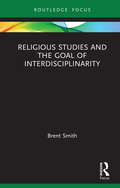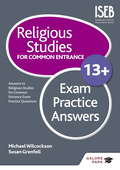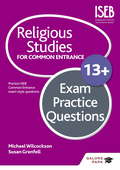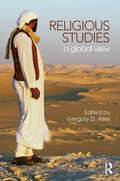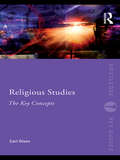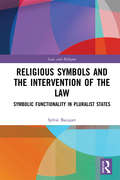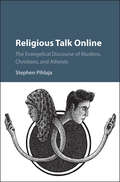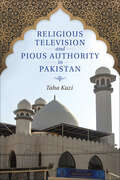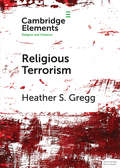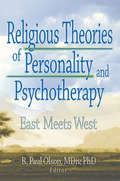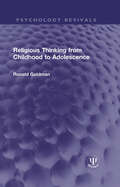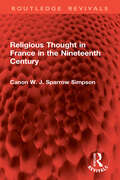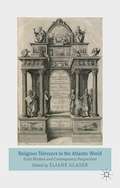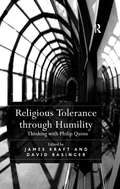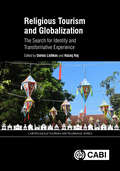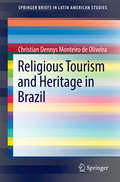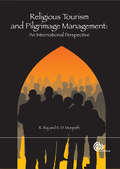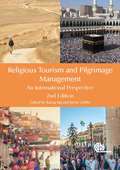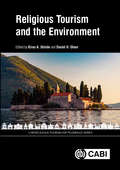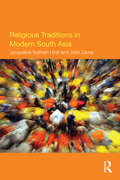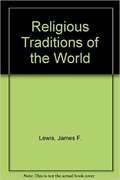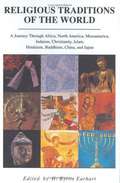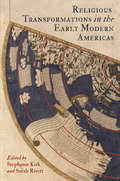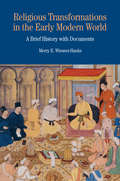- Table View
- List View
Religious Studies and the Goal of Interdisciplinarity (Routledge Focus on Religion)
by Brent SmithThis book offers a survey of the development of interdisciplinarity in religious studies within academia and offers ways for it to continue to progress in contemporary universities. It examines the use of the term ‘interdisciplinary’ in the context of the academic study of religion and how it shapes the way scholarly work in this field has developed. The text uses two main elements to discuss religious studies as a field. Firstly, it looks at the history of the development of religious studies in academia, as seen through an interdisciplinary critique of the university as an epistemological project. It then uses the same interdisciplinary critique to develop a foundation for a 21st-century hermeneutic, one which uses the classical concepts reprised by that interdisciplinary critique and retools the field for the 21st century. Setting out both the objects of religious studies as a subject and the techniques used to employ the study of those objects, this book offers an invaluable perspective on the progress of the field. It will, therefore, be of great use to scholars of research methods within religious studies.
Religious Studies for Common Entrance 13+ Exam Practice Answers
by Michael Wilcockson Susan GrenfellThis book provides all answers, as well as marking guidance, to the questions in the accompanying title Religious Studies for Common Entrance 13+ Exam Practice Questions. - Endorsed by ISEB- Provides extensive advice and guidance to help pupils achieve top marks - Saves time marking work and helps identify areas requiring further study
Religious Studies for Common Entrance 13+ Exam Practice Questions
by Michael Wilcockson Susan GrenfellThis book contains over 900 exam-style questions based on Syllabus A of the 13+ ISEB Common Entrance exam; it is ideal for pupils who are looking to achieve top grades in entrance exams at 13+. The guide is laid out to correspond with the examination paper and includes sections on Biblical Stories, World Religions and Contemporary Issues, allowing pupils to familiarise themselves with the format of the exam. It also includes advice on how to answer exam questions.- Endorsed by ISEB- Ideal for pupils working towards Syllabus A of the Religious Studies Common Entrance exam at 13+- Features rigorous exam-style questions for realistic practice
Religious Studies: A Global View
by Gregory D. AllesDrawing on recent developments in the comparative study of religion, this book explores the trends of the past sixty years from a global perspective. Each of the ten chapters covers the study of religion in a different region of the world, from Europe and the Americas to Asia and the Far East. Topics covered include: local background to the study of religions formation of religious studies in the region important thinkers and writings institutions interregional diversity and interregional connections emerging issues. This book is a major contribution to the field of religious studies and a valuable reference for scholars, researchers and graduate students.
Religious Studies: The Key Concepts (Routledge Key Guides)
by Carl OlsonReligious Studies: The Key Concepts is an accessible, A-Z resource, defining and explaining key terms and ideas central to the study of religion. Exploring broad and recurring themes which are applicable in both eastern and western religions, cross-cultural examples are provided for each term to give a comprehensive overview of the subject. Subjects covered include: afterlife comparative religion festivals ethics gender monotheism world religions modernity pilgrimage theism secularization With cross referencing and further reading provided throughout, this book provides an inclusive map of the discipline, and is an essential reference for all students, academics and researchers.
Religious Symbols and the Intervention of the Law: Symbolic Functionality in Pluralist States (Law and Religion)
by Sylvie BacquetIn contemporary pluralist states, where faith communities live together, different religious symbols and practices have to coexist. This may lead to conflicts between certain minority practices and the dominant majority, particularly around the manifestation of belief in the public domain which may be seen both by the religious and secular majorities as a threat to their cultural heritage or against the secular values of the host country. The law has to mitigate those tensions in order to protect the public from harm and preserve order but in doing so, it may where necessary have to limit citizens’ ability to freely manifest their religion. It is those limitations that have been disputed in the courts on grounds of freedom of religion and belief. Religious symbols are often at the heart of legal battles, with courts called upon to consider the lawfulness of banning or restricting certain symbols or practices. This book analyses the relationship between the state, individuals and religious symbols, considering the three main forms of religious expression, symbols that believers wear on their body, symbols in the public space such as religious edifices and rituals that believers perform as a manifestation of their faith. The book looks comparatively at legal responses in England, the U.S.A and France comparing different approaches to the issues of symbols in the public sphere and their interaction with the law. The book considers religious manifestation as a social phenomenon taking a multidisciplinary approach to the question mixing elements of the anthropology, history and sociology of religion in order to provide some context and examine how this could help inform the law.
Religious Talk Online: The Evangelical Discourse of Muslims, Christians, and Atheists
by Stephen PihlajaIn the online world, people argue about anything and everything - religion is no exception. Stephen Pihlaja investigates how several prominent social media figures present views about religion in an environment where their positions are challenged. The analysis shows how conflict creates a space for users to share, explain, and develop their opinions and beliefs, by making appeals to both a core audience of like-minded viewers and a broader audience of viewers who are potentially interested in the claims, ambivalent, or openly hostile. The book argues that in the back-and-forth of these arguments, the positions that users take in response to the arguments of others have consequences for how religious talk develops, and potentially for how people understand and practice their beliefs in the twenty-first century. Based on original empirical research, it addresses long-debated questions in sociolinguistics and discourse analysis regarding the role of language in building solidarity, defining identity and establishing genres and registers of interaction. Develops new methods for social media research; Explains and expands the development of inter-religious dialogue in online contexts; Provides new insights into how online environments affect religious belief and religious interaction.
Religious Television and Pious Authority in Pakistan
by Taha KaziIn Pakistan, religious talk shows emerged as a popular television genre following the 2002 media liberalization reforms. Since then, these shows have become important platforms where ideas about Islam and religious authority in Pakistan are developed and argued. In Religious Television and Pious Authority in Pakistan, Taha Kazi reveals how these talk shows mediate changes in power, belief, and practice. She also identifies the sacrifices and compromises that religious scholars feel compelled to make in order to ensure their presence on television. These scholars, of varying doctrinal and educational backgrounds—including madrasa-educated scholars and self-taught celebrity preachers—are given screen time to debate and issue religious edicts on the authenticity and contemporary application of Islamic concepts and practices. In response, viewers are sometimes allowed to call in live with questions. Kazi maintains that these featured debates inspire viewers to reevaluate the status of scholarly edicts, thereby fragmenting religious authority. By exploring how programming decisions inadvertently affect viewer engagements with Islam, Religious Television and Pious Authority in Pakistan looks beyond the revivalist impact of religious media and highlights the prominence of religious talk shows in disrupting expectations about faith.
Religious Terrorism (Elements in Religion and Violence)
by Heather GreggHow can the world's religions, which propagate peace and love, promote violence and the killing of innocent civilians through terrorist acts? This Element aims to provide insights into this puzzle by beginning with a brief overview of debates on terrorism, a discussion on religion and the various resources it provides groups engaging in terrorist acts, four arguments for what causes religious terrorism, brief examples of religious terrorism across faith traditions, and a synopsis of deradicalization programs. This discussion shows that, when combined with certain political and social circumstances, religions provide powerful resources for justifying and motivating terrorist acts against civilians.
Religious Theories of Personality and Psychotherapy: East Meets West
by Frank De Piano Ashe Mukherjee Scott Mitchel Kamilar Lynne M Hagen Elaine Hartsman R. Paul OlsonIntegrate spiritual traditions with psychological healing!In this fascinating volume, clinical practitioners of different religious traditions examine the same clinical case, offering insights, interventions, and explanations of transformation and healing. This practical approach allows them to explore broader issues of personality theory and psychology from the perspectives of various spiritual traditions: Hinduism, Buddhism, Taoism, Judaism, Christianity, and Islam. Religious Theories of Personality and Psychotherapy addresses both the practical issues of doing psychotherapy and the deeper need to relate psychology and theology. After providing a thorough introduction to the spiritual tradition, each author presents a critical psychological theory of personality and psychotherapy grounded in that tradition. The authors address the questions of what it means to be a person, what causes human distress, and how individuals experience healing. Religious Theories of Personality and Psychotherapy offers profound insights into the urgent issues of human suffering and psychological transformation, including: theories of personality structure and human motivation the nature of experience and processes of change the dialectical relation of theology and psychology convergences and difference among the religious psychologiesMarrying theory and practice, spirit and psyche, Religious Theories of Personality and Psychotherapy offers profound insights and effective interventions. Mental health professionals, clergy, and scholars in religion, cross-cultural studies, personality, counseling, and psychotherapy will find this breakthrough book a life-changing experience and an invaluable resource.
Religious Thinking from Childhood to Adolescence (Psychology Revivals)
by Ronald GoldmanFirst published in 1964, Religious Thinking from Childhood to Adolescence describes the capacities of pupils of varying ages, abilities and backgrounds to understand religious truths. How concepts of the Bible, of God, of Jesus, of Prayer and of the Church developed from the early years is seen within the psychological context of maturing thought, and the implications for religious education, which are provocative and far-reaching, are explored. Teachers, clergy and parents will find this book a challenge to reconsider not only how the growing child views what he is taught but also the reasons why he frequently misunderstands religious teaching. By presenting a systematic account of religious thinking from 6 to 17 years, Dr. Goldman adds a new dimension to our insights into child development.
Religious Thought in France in the Nineteenth Century (Routledge Revivals)
by Canon W. SimpsonFirst published in 1935, Religious Thought in France in the Nineteenth Century discusses various religious thoughts prevalent in France during the nineteenth century, along with prominent figures associated with them. The author explores Positivist Religion, Natural Religion, and Older and Newer Protestantism. He then talks about the modernist movement in France through the life and career of distinguished critic Alfred Loisy. The author goes on to examine the future of religion and the influence of Bergson and provides a commentary on the biblical and historical studies among Catholics, Catholic studies of Dogma and the preachers in Paris like Mgr. de Quélen, Jesuit Ravignan, Jesuit Félix, Père Hyacinthe and Monsabré, to name a few. Simpson concludes his book with a discussion on the influence of Church on literary men – Bourget, Huysmans, Faguet, and Brunetière.
Religious Tolerance in the Atlantic World
by Eliane GlaserPlacing topical debates in historical perspective, the essays by leading scholars of history, literature and political science explore issues of difference and diversity, inclusion and exclusion, and faith in relation to a variety of Christian groups, Jews and Muslims in the context of both early modern and contemporary England and America.
Religious Tolerance through Humility: Thinking with Philip Quinn
by David BasingerThe acclaimed scholars contributing to this volume place under scrutiny a fascinating alternative proposal for a pathway to religious tolerance - that serious consideration of religious diversity tends to reveal the weakness of support many have for their religious commitments, and the humility produced tends to result in religious tolerance. The authors illuminate the debate within philosophy about the way beliefs are supported, the controversy between internalism and externalism, and disagreement about how humility and tolerance are related. Critical and supportive views are represented so that the main lines of agreement and disagreement rise to the surface and are mapped out for the first time. The collection honours Philip Quinn who advocated the pathway so rigorously that the special attention given to his views focuses and deepens the critical discussion. Original essays by some of the most respected contemporary intellectuals in this field make this collection especially attractive.
Religious Tourism and Globalization: The Search for Identity and Transformative Experience (CABI Religious Tourism and Pilgrimage Series)
by Dr Nour Farra-Haddad Vitor Ambrósio Alison T. Smith Jaffer Idris Dimitrios Mylonopoulos Ricardo Nicolas Progano Silvia Aulet Serrallonga Spyridon Parthenis Dr Dino Bozonelos Polyxeni Moira Caglar Bideci Mujde Bideci Elzbieta Bilska-Wodecka Stephen F. Haller Antonietta Ivona Isilda Leitão Eleanor O’Keeffe Donatella PriviteraIs it possible to identify the positive and negative effects of globalization on religious tourism or to estimate the transformation of the internal and external constructs of pilgrimage by these effects? In order to address these questions, this book highlights the importance of the search for identity and transformative experience during religious tourism. It also looks at how, recently, globalization has played a part in the changes of the concept of personal and social identity and the transformative experience of pilgrimage. The chapters, consisting of carefully selected case studies, analyse possible effects including the adoption of different new rituals, new pilgrims' values, changes of tradition, acceptance of technologic innovations, development of new business models, and other environmental and sociocultural changes. The book provides: · a conceptual framework for understanding the impacts of globalization; · integrated cross-disciplinary approaches; and · an insight into major religious travel practices in the age of identity challenges and worldwide transformations. It will be suitable for researchers and students of religious tourism, pilgrimage, identity tourism, as well as related subjects such as sociology, anthropology, psychology, theology, history and cultural studies.
Religious Tourism and Heritage in Brazil
by Christian Dennys Monteiro OliveiraThe book reflects on the current dimensions of tourism and patrimony in Brazil. It presents cultural realities as resources for the resolution of tensions between different communities and the establishment of their identities. The book also presents memories and forgotten traditions that are important in the representation of places and cultures. It questions religious systems and their dynamic interface with the occupation of cultural spaces and the interpretation of touristic practices in Brazil. The topics discussed include pilgrimages, sanctuaries, symbolic vectors, and religious festivals.
Religious Tourism and Pilgrimage Festivals Management: An International Perspective
by Razaq Raj Nigel D. MorpethIn case studies, researchers in tourism from Europe, China, Australia, and Canada present personal, theoretical, and empirical insights into pilgrimage, religion, and tourism. They explore increasing linkages and interconnections between shared sacred and secular spaces; religious and pilgrimage activity related to ancient, sacred, and emerging tourist destinations; and new forms of pilgrimage, faith systems, and quasi-religious activities.
Religious Tourism and Pilgrimage Management: An International Perspective (2nd Edition)
by Razaq Raj Neil Robinson Ian Rotherham Alan Clarke Dr Nour Farra-Haddad Carlos Fernandes Silvia Aulet Vitor Ambrósio Elizabeth Ifeyinwa Benson Nigel Bond Miguel Brázio Geoffrey Skoll Dr Dolors Vidal Ruth Blackwell Hadil Faris Dr Maria Leppakari Michael O’ Regan Yasin Bilim Jorge Coelho Jaeyeon Choe Tahir Rashid Samson Olawale Fadare Sevde Düzgüner Maximiliano Korstanje Lluis Prats Vincent Zamitt Anna Trono Kevin Griffin Agnes RaffayWithin the past 10 years 'Religious Tourism' has seen both economic and education-sector growth on a global scale. This book addresses the central role of religious tourism and interrelationships with other aspects of pilgrimage management. It provides practical applications, models and illustrations and looks at secular and sacred spaces on a global stage. The second edition sees the introduction of a new structure and the addition of new international case studies. It is an invaluable reference for academics, students and practitioners and is a timely text on the future of faith-based tourism and pilgrimage.
Religious Tourism and the Environment (CABI Religious Tourism and Pilgrimage Series)
by Kiran A. Shinde and Daniel H. OlsenThe remarkable growth in religious tourism across the world has generated considerable interest in the impacts of this type of tourism. Focusing here on environmental issues, this book moves beyond the documentation of environmental impacts to examine in greater depth the intersections between religious tourism and the environment. Beginning with an in-depth introduction that highlights the intersections between religion, tourism, and the environment, the book then focuses on the environment as a resource or generator for religious tourism and as a recipient of the impacts of religious tourism. Chapters included discuss such important areas as theological views, environmental responsibility, and host perspectives. Covering as many cultural and environmental regions as possible, this book provides: -An in-depth yet holistic view of the relationships between religious tourism and the environment; -A conceptual framework that goes beyond listing potential environment impacts; -A strong focus on explaining the universality of the deeper environmental issues surrounding sacredness and sacred places; -A discussion of the role of disease and health-related issues at mass religious gatherings. From a global writing team and featuring case studies spanning Europe and Asia, this book will be of great interest to researchers and students of tourism and religious studies, as well as those studying environmental issues.
Religious Traditions in Modern South Asia
by John Zavos Jacqueline Suthren HirstThis book offers a contemporary approach to the study of religion in modern South Asia. It explores the development of religious ideas and practices in the region, giving students a clear and critical understanding of social, political and historical context. Part One takes a fresh look at some familiar themes in the study of religion, such as deity, authoritative texts, myth, worship, teacher traditions and caste, and helps students understand diverse ways of approaching these themes. Part Two focuses on some of the key ways in which Buddhism, Hinduism, Islam and Sikhism in South Asia have been shaped in the modern period. Overall the book considers the impact of gender, politics, and the way religion itself is variously understood. The chapters contain a compelling range of primary source materials and a series of geographical and historical ‘snapshots’ to orientate readers to South Asia. Valuable features for students include images, task boxes, discussion points, suggestions for further reading, a timeline and glossary of terms.
Religious Traditions of the World
by James F. Lewis William G. TravisA survey of the religious traditions of the world with a theological evaluation of selected main ideas. The emphasis is on the history, development, scriptures, beliefs, and practices of the world's great religions. Full of pictures, illustrations, charts and maps.
Religious Traditions of the World: A Journey Through Africa, Mesoamerica, North America, Judaism, Christianity, Islam, Hinduism, Buddhism, China, And Japan
by H. Byron EarhartNow in one volume: the ten volumes of the outstanding Religious Traditions of the World series. Written by leading experts, these individual studies explore the richness and variety of important religions from around the world.
Religious Transactions in Colonial South India
by Hephzibah IsraelThis book studies conversions to Christianity and the growth of Christian identity in colonial South India.
Religious Transformations in the Early Modern Americas (The Early Modern Americas)
by Sarah Rivett Stephanie KirkChristianity took root in the Americas during the early modern period when a historically unprecedented migration brought European clergy, religious seekers, and explorers to the New World. Protestant and Catholic settlers undertook the arduous journey for a variety of motivations. Some fled corrupt theocracies and sought to reclaim ancient principles and Christian ideals in a remote unsettled territory. Others intended to glorify their home nations and churches by bringing new lands and subjects under the rule of their kings. Many imagined the indigenous peoples they encountered as "savages" awaiting the salvific force of Christ. Whether by overtly challenging European religious authority and traditions or by adapting to unforeseen hardship and resistance, these envoys reshaped faith, liturgy, and ecclesiology and fundamentally transformed the practice and theology of Christianity.Religious Transformations in the Early Modern Americas explores the impact of colonial encounters in the Atlantic world on the history of Christianity. Essays from across disciplines examine religious history from a spatial perspective, tracing geographical movements and population dispersals as they were shaped by the millennial designs and evangelizing impulses of European empires. At the same time, religion provides a provocative lens through which to view patterns of social restriction, exclusion, and tension, as well as those of acculturation, accommodation, and resistance in a comparative colonial context. Through nuanced attention to the particularities of faith, especially Anglo-Protestant settlements in North America and the Ibero-Catholic missions in Latin America, Religious Transformations in the Early Modern Americas illuminates the complexity and variety of the colonial world as it transformed a range of Christian beliefs.Contributors: Ralph Bauer, David A. Boruchoff, Matt Cohen, Sir John Elliot, Carmen Fernández-Salvador, Júnia Ferreira Furtado, Sandra M. Gustafson, David D. Hall, Stephanie Kirk, Asunción Lavrin, Sarah Rivett, Teresa Toulouse.
Religious Transformations in the Early Modern World: A Brief History With Documents (Bedford Cultural Editions Series)
by Merry E. Wiesner-HanksThe early modern period witnessed sometimes startling, sometimes subtle transformations in the religious and intellectual life of peoples across the globe. For reasons that varied widely, leaders and thinkers from Mexico to the Ottoman Empire and from China to the Indian subcontinent sought to reform existing religions, develop new spiritual practices, promote innovative texts, and, on occasion, even create new religions. <P><P>Presenting documents from different regions and different religious and philosophical traditions, including Islam, Judaism, Sikhism, Christianity, and Confucianism, this volume allows students to explore and analyze these varied transformations. A general introduction introduces the framework for examining the chapter case studies, while the chapters provide context, a group of primary sources, and a set of questions to consider. Useful pedagogic supports include headnotes to the documents, a chronology, a set of broader questions to consider that help students compare transformations, a selected bibliography, and an index.
